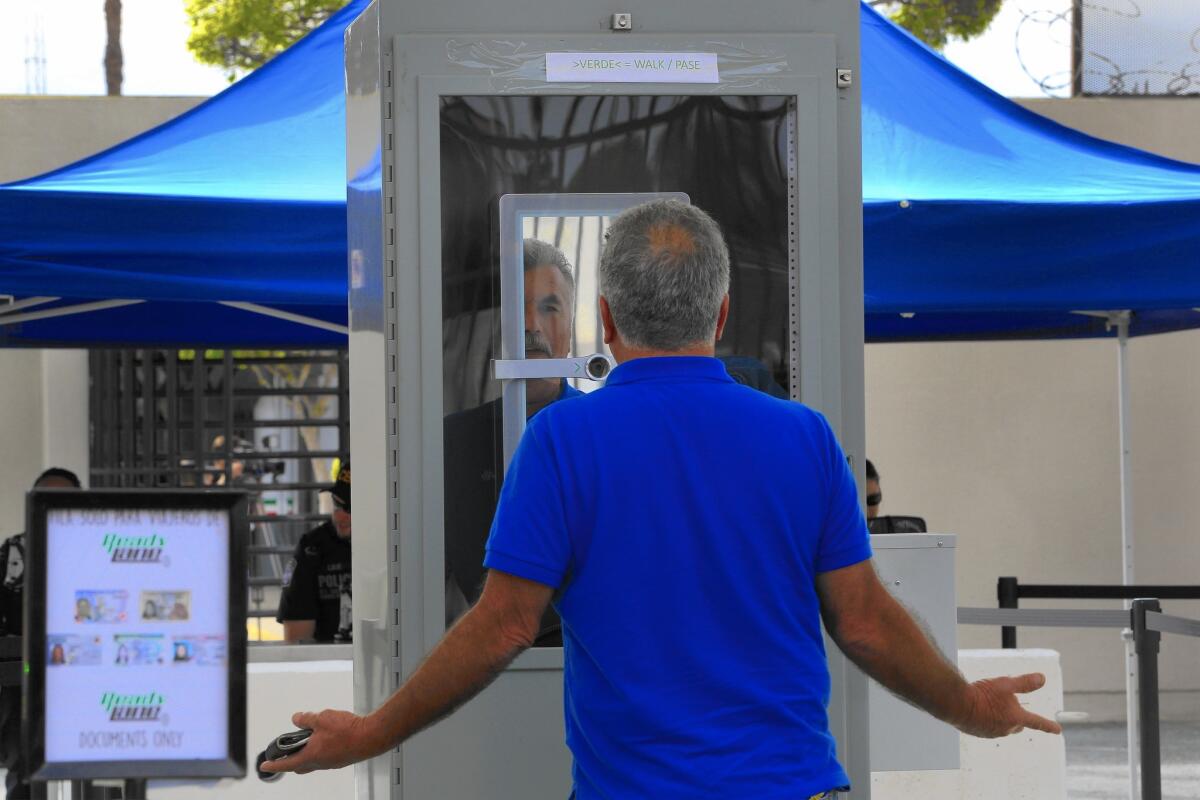Otay Mesa border crossing uses facial scanners for screening departing foreigners

Through the end of April, all pedestrians leaving San Diego through Otay Mesa will be screened, but only foreigners will have their identities documented through iris scans and facial recognition technology.
- Share via
reporting from OTAY MESA, Calif. — High-tech equipment capable of scanning faces and reading irises for the first time is being used at a U.S. land border to verify the identities of foreigners leaving the country. U.S. Customs and Border Protection inspectors are now screening pedestrians crossing into Mexico at Otay Mesa.
“We want to know when a person comes into the country, and we want to know when they leave,” said Charmaine Rodriguez, assistant port director at Otay Mesa.
The test, which began last week, is part of an effort that uses biometrics to crack down on the use of fraudulent documents and track foreigners who remain in the United States with expired visas. Through the end of April, all pedestrians leaving San Diego through Otay Mesa will be screened, but only foreigners will have their identities documented through iris scans and facial recognition technology.
Biometrics measure a person’s unique physical characteristics, through methods that include the reading of fingerprints, irises and facial bone structure. CBP has been verifying travelers’ identities through fingerprints since 2004.
The biometric testing responds to a longstanding demand by Congress that the U.S. Department of Homeland Security track the departure of foreigners who enter the country with non-immigrant visas but remain in the country after the expiration date. A 2006 study by the Pew Hispanic Center estimated that visa overstays made up as much as half of the country’s undocumented population.
Except for sporadic checks for guns, bulk cash and stolen vehicles by CBP, those crossing into Mexico rarely submit to U.S. inspections. Until now, there has been little scrutiny of pedestrians leaving the country through Otay Mesa either by U.S. or Mexican authorities.
CBP’s southbound U.S. inspections at Otay Mesa separate crossers into two categories: U.S. citizens and non-U.S. citizens. U.S. citizens with passport cards or other radio-frequency identification documents that can be read by machines are being asked to swipe their cards before crossing — thus recording their departure through biographic information.
The biometric testing applies to most non-U.S. citizens ages 14 to 79. Some will be asked to look at a camera as they walk through, while others are being directed to a machine that reads their faces and irises. The images are matched to a database that CBP has been collecting since December of foreigners crossing northbound at Otay Mesa.
According to CBP, 9,000 pedestrians a day cross into the United States through the Otay Mesa Port of Entry, while about 6,000 leave the country. Rodriguez said that anyone found to have overstayed their U.S. visa will be processed “on a case-by-case basis.” Inspectors “would use our normal processing for a person who has overstayed their visa. It might be a simple annotation versus a more formalized process.”
If results are successful, the testing will not immediately be duplicated at other border crossings, Rodriguez said. “There will be a rather extensive review of the data, that could take several months,” she said. “I’d say this is a limited test in a limited environment. What works here is not going to work all across the southern border, or ultimately if we end up using it on the northern border.”
More to Read
Sign up for Essential California
The most important California stories and recommendations in your inbox every morning.
You may occasionally receive promotional content from the Los Angeles Times.













